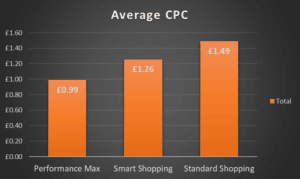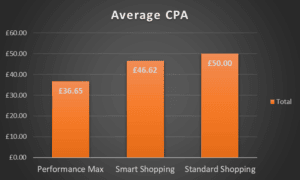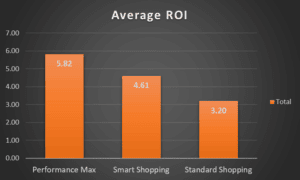The Truth Behind Google Ads Performance Max Campaign Type
The time has come to dive into the nitty gritty, facts and stats about Google Ad’s newest campaign type: Performance Max. We can all admit when the campaign type was first announced we were sceptical, one campaign showing across multiple networks was a very novel concept, after all, mixing match types in campaigns is a strict no-no, so mixing networks… like I said sceptical. However, we have now been using Performance Max for a human-sized 9-months and although we’ve experienced a fair amount of teething problems, performance across most industries is undeniably greater.
What is Performance Max?
For those unfamiliar with the Performance Max campaign type, unlike other campaigns that show across 1-2 channels, Performance Max shows your carefully curated ads across the entire Google Ads inventory, that’s Search, Display, YouTube, Discover, Gmail, and Maps all from one campaign. It is classed as a more automated campaign type but not as automated as a smart campaign and due to its widespread serving abilities, as of September 2022 local, smart, and smart shopping campaigns will all be replaced by mighty PMax. So, let’s get stuck in and discuss the what’s, why’s, benefits, and drawbacks of Google’s newest campaign type.
What type of business is best suited to Performance Max?
If you had asked our agency this a few months ago we would have confidently told you Performance Max works best for e-commerce businesses in the B2C sector. Whilst this still stands, we now have PMax campaigns running on every one of our client’s accounts, exactly 50% of which are lead generation businesses. I say this with a warning, lead gen accounts must have accurate conversion tracking set up for Performance Max campaigns to run successfully. Although this is the case with any campaign in any account, due to the goal-based automation of PMax campaigns, the bidding strategies on offer here are the sophisticated “maximize conversions” and “maximize conversion value” – so that conversion tracking needs to be pretty flawless.
The benefits of using Performance Max campaigns:
A plethora of targeting options: Similar to display campaigns, PMax campaigns allow advertisers to use a combination of audience signals to target highly relevant consumers. Construct your own pick and mix of targeting types, from keywords and competitor site visitors to demographics and CRM lists. Tip: why create a generic audience signal for your PMax campaign when you could make it asset group specific?
- Faster learning, better results: Whilst every campaign has a learning period, Performance Max’s ability to show ads to the right users at the right time on the right channel due to its advanced machine learning and attribution technology enables quicker data-driven optimisations and stronger campaign performance.
- Richer insights: Without knocking the recommendations tab, the new “insights” section available for Performance Max campaigns is a game changer for e-commerce brands previously using Smart Shopping. Discover top conversion-driving topics/keywords along with week-on-week and month-on-month insights – yes there is still automation there, but Google is giving us a bit more transparency *thanking the PPC gods*.
- Higher efficiency & conversions: Google claims accounts using Performance Max campaigns should expect to see a 12% increase in conversion value when upgrading from smart shopping. From our own agency experience, we have seen a considerable decrease in CPCs, a stronger conversion rate resulting in higher conversions and ROAS, lower costs, and healthier CPAs… so wait, are there any drawbacks to Google’s newest campaign type?
The drawbacks of using Performance Max campaigns:
- Long-winded keyword negation: As Performance Max campaigns show across every Google network under the sun, including search, it can show for many irrelevant queries (we see you broad match) driving unwanted traffic to the site. Unlike the easy negative keywords tab available within search campaigns, you are only able to negate keywords via your Google account manager or raising a query with Google support asking them to negate them out. Our advice here is to send over a list of obvious negations and branded terms as soon as you go live, minimising unwanted traffic & maximising campaign efficiency from the offset
- No channel breakdown: I know what you’re thinking, I bet I can find out where conversions are coming from, campaigns >> segment >> network (with search partners) >> bingo! Tried and tested my friends, our PMax campaigns simply show as driving all conversions from “cross-network”. What you can see is one week there may be a spike in impressions which you can gauge means the campaign served on the display network. Seeing which channels drove the most conversions, or which channels our ads were shown on from one week to the next would be uber helpful when it comes to reporting – “but where’s the fun in that?” said Google. Tip: you are now able to see display/video performance through building a custom report including “placements” and if you want to minimise serving on the display network, Google tells us you can turn off the display expansion.
- No quality scores: Now as a data-driven marketer, the more information to analyse the better, and our (lovely and detailed) 3-factor quality score has been replaced by a simple “performance” column ranking our assets from poor to best *sigh*, although the “improve your asset groups” function is highly informative in helping you improve asset group ad strength from poor to excellent so I guess you can’t have it all.
- No asset group performance: Yes you can see landing page performance in analytics, and I pray that someone tells me I am wrong but in my mind, asset groups should show me as much performance data as ad groups in any other campaign type. Unfortunately, they do not, and we do have to take other routes to find out which was the best performer, nothing an update won’t fix hey Google!
When using Performance Max campaigns, be mindful of…
- Final URL expansion: This section of PMax set-up can be easily missed due to being hidden at the bottom of the campaign settings page under the collapsible box named “additional settings”. By default, final URL expansion is set to on, meaning the campaign can send traffic to the most relevant page on your website, despite specifying the webpage in your asset group, essentially turning the campaign into a dynamic ad.
- Using a low budget: This is more of a “proceed with caution” warning, whilst we have seen a much-improved performance from clients with smaller media spend and Pmax campaigns on just £5/day, Google does advise a slightly higher daily budget on Performance Max campaigns. The reason for this is that it’s like having 6 campaigns in 1 due to its multi-channel serving abilities – we have noticed clients with smaller budgets can see large fluctuations week-on-week in clicks and conversions due to serving on the display network one week and search the next, bigger budgets mean quicker learnings and more stable performance during that initial phase.
Performance Max case study:
After acquiring an online wine merchant client in November 2020, we began transitioning the Standard Shopping campaigns over to Smart Shopping, these ran with great success improving the client’s average CPC from £1.49 to £1.26, their ROI from 3.2 to 4.61 and their CPA from £50 to £46. We continued running these campaigns, segmenting out high-performing products into their own campaigns and optimising towards a target ROAS for the entirety of 2021. Then in December that year Performance Max was launched and since January 2022 we have been slowly transitioning our Smart Shopping campaigns to Google’s newest campaign type. The below graphs demonstrate the improvements from Standard Shopping to Performance Max measuring data across a 3-month period:

The above graph shows the client’s CPC improving further from Smart Shopping’s £1.26 down to PMax’s £0.99 – a 21% decrease after a 15% decrease from Standard to Smart Shopping, totalling a 33% improvement in CPC from December 2022 to present day.

Along with the clients CPC’s improving, CPA now sits at £36.65 when using the Performance Max campaigns, oppose to the 21% higher £46.62 when using Smart Shopping, with a total improvement of 26% from Standard Shopping performance.

Finally, not only did campaign efficiency improve with each campaign type upgrade for our online wine merchant, their return on investment also improved 26% from Smart Shopping after an impressive 44% increase from Standard Shopping back in December 2020.
Want to know more about Performance Max?
It’s an ever-changing digital landscape out there and it can be hard to navigate. Performance Max is one of many Google updates brought out to help businesses drive better results from advertising on their platform and it’s not easy to keep up with the updates. That’s where we come in. As experts in all things digital, we offer tailored marketing services to suit all types of businesses, from start-ups to global brands across any and all industries. Whether you are looking for the full digital package, inclusive of SEO, PPC, social media, and strategy, or simply after some friendly advice, get in touch with us today.

